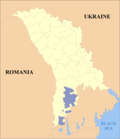Vulcănești
Vulcănești
Valkaneş | |
|---|---|
Town | |
 Coat of arms | |
 Vulcănești Location of Vulcănești in Moldova | |
| Coordinates: 45°41′00″N 28°24′10″E / 45.68333°N 28.40278°ECoordinates: 45°41′00″N 28°24′10″E / 45.68333°N 28.40278°E | |
| Country | Moldova |
| Autonomous Region | Gagauzia |
| Government | |
| • Mayor | Victor Petrioglu (PN[1]) |
| Area | |
| • Total | 15.26 km2 (5.89 sq mi) |
| Population | |
| • Total | 12,185 |
| • Density | 800/km2 (2,100/sq mi) |
| Time zone | UTC+2 (EET) |
| Climate | Cfa |
Vulcănești (Romanian pronunciation: [vulkəˈneʃtʲ]; Gagauz: Valkaneş) a town in Gagauzia, Moldova. The Vulcănești area is the southern exclave of Gagauzia surrounded by the Cahul District (Moldova) and Odessa Region (Ukraine).
One village-rail station also named Vulcănești, is administered by the city.
It was the site of an archaeological investigation, which found a Neolithic sculpture that echoes Rodin's The Thinker.[3][4]
Media[]
- Vocea Basarabiei 106.7
See also[]
References[]
- ^ "Lista primarilor aleși în cadrul Alegerilor Locale Generale din 14 iunie 2015". Central Election Commission of Moldova. 2015. Retrieved 15 April 2016.
- ^ Results of Population and Housing Census in the Republic of Moldova in 2014: "Characteristics - Population (population by communes, religion, citizenship)" (XLS). National Bureau of Statistics of the Republic of Moldova. 2017. Retrieved 2017-05-01.
- ^ Gimbutas, Marija (1982). "The 'Sorrowful God'". The Goddesses and Gods of Old Europe 6500-3500 B.C. Myths and Cult Images. Berkeley and Los Angeles: University of California Press. pp. 230–234. ISBN 0-520-04655-2.
- ^ Passek, T.S.; Gerasimov, M.M. (1967). "Novaja statuetka iz Vulkaneshty". KSIIMK Archaeological Museum of the Institute of History of the Moldavian Socialist Republic. 111: 38–41.
Categories:
- Cities and towns in Moldova
- Gagauzia
- Southern Moldova geography stubs


